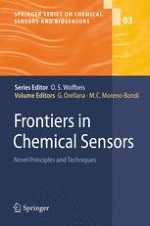With their similarity to the organs of the most advanced creatures that inhabit the Earth, sensors are regarded as being the “senses of electronics”: arti?cial eyes and ears that are capable of seeing and hearing beyond the range of - man perception; electronic noses and tongues that can recognise odours and ?avours without a lifetime training; touch that is able not only to feel the texture and temperature of the materials but even to discern their chemical compo- tion. Among the world of chemical sensors, optical devices (sometimes termed “optodes”, from the Greek “the optical way”) have reached a prominent place in those areas where the features of light and of the light-matter interaction show their advantage: contactless or long-distance interrogation, detection sensitivity, analyte selectivity, absence of electrical interference or risks, and lack of analyte consumption, to name just a few. The introduction of optical ?bres and integrated optics has added more value to such sensing since now light can be con?ned and readily carried to dif?cult-to-reach locations, higher information density can be transported, indicator dyes can be immobilised at the distal end or the evanescent ?eld for unique chemical and biochemical sensing (including multiplexed and distributed measurements), optical s- sors can now be subject to mass production and novel sensing schemes have been established (interferometric, surface plasmon resonance, ?uorescence energy transfer, supramolecular recognition . . . ).
